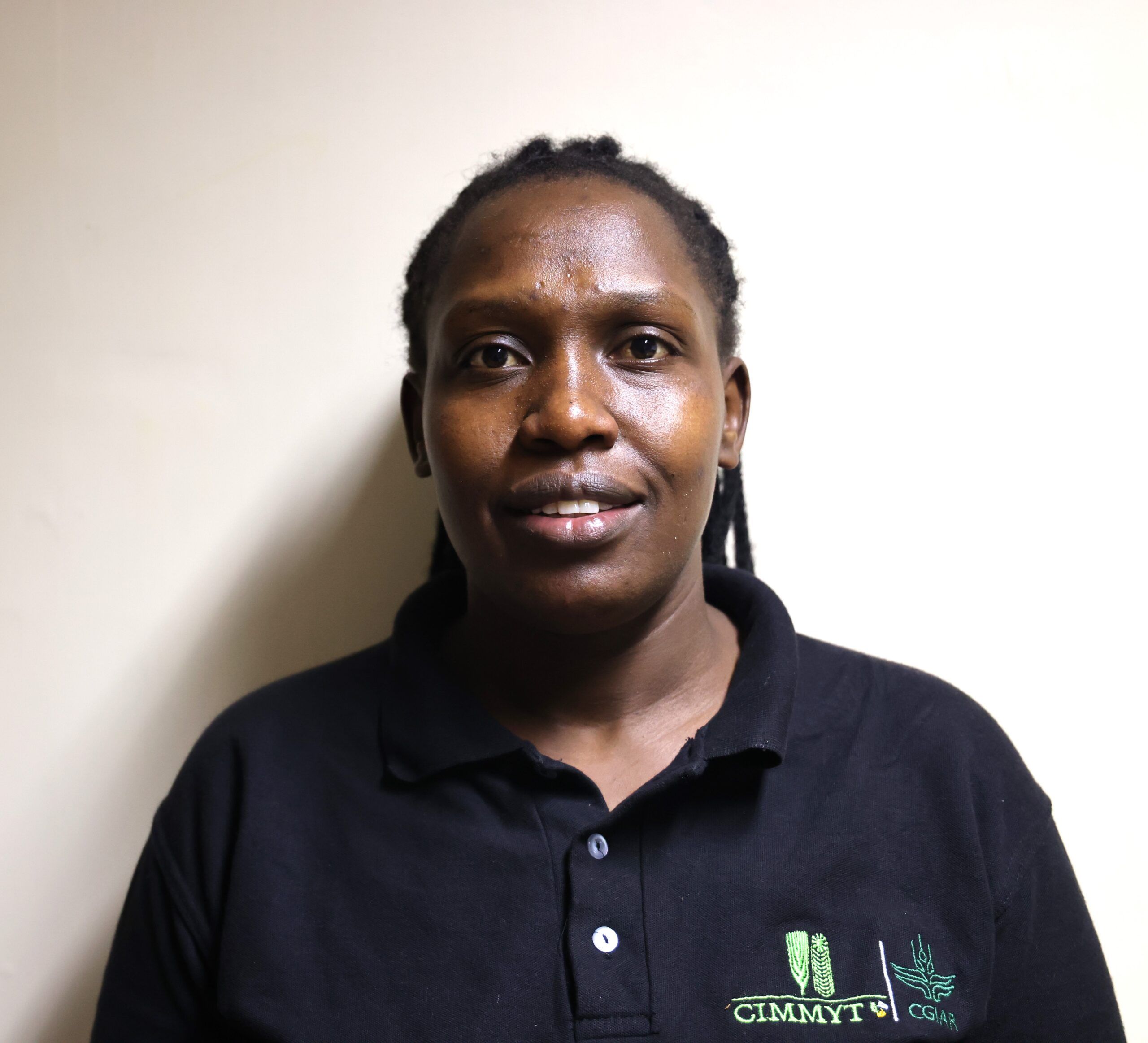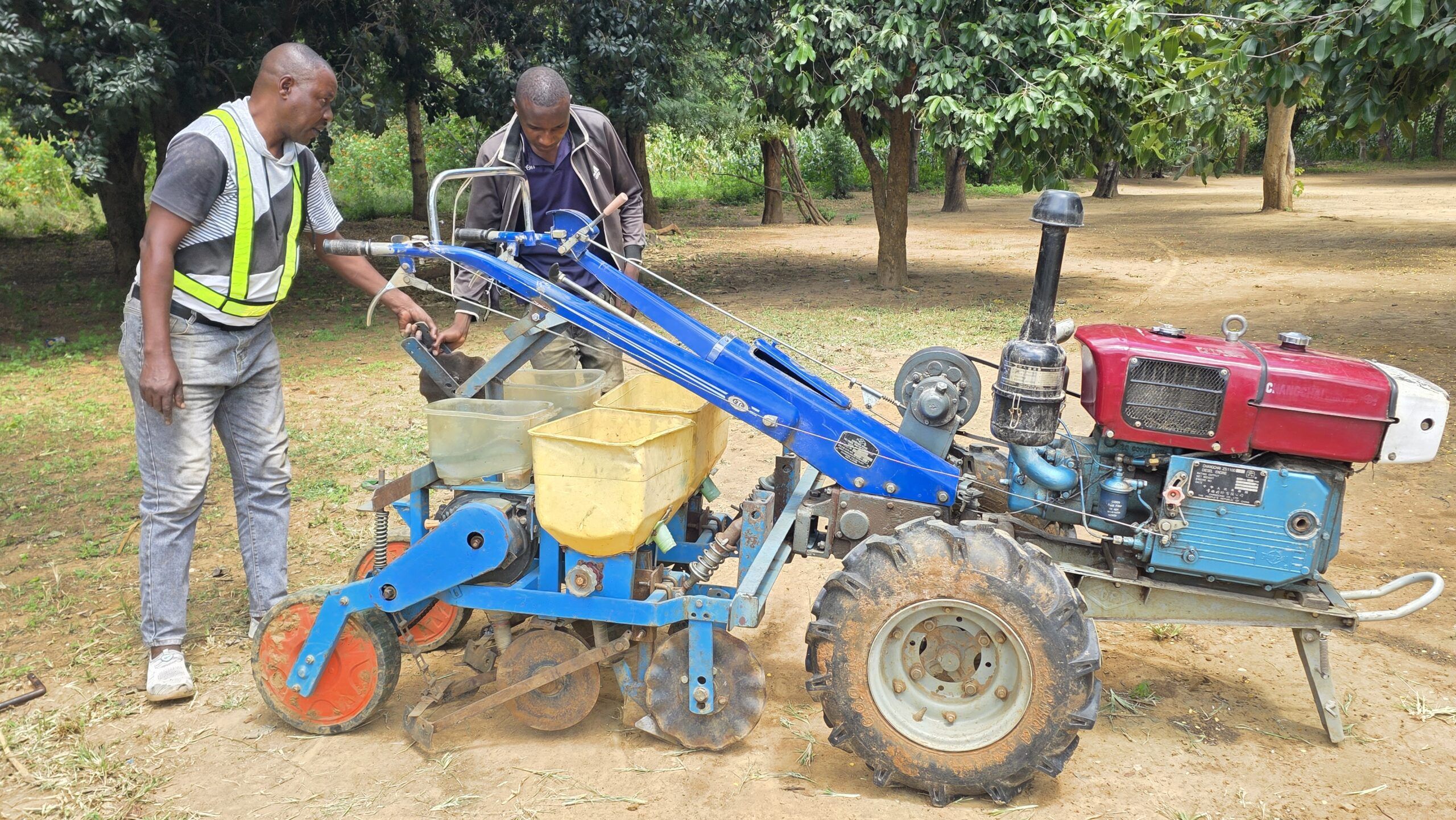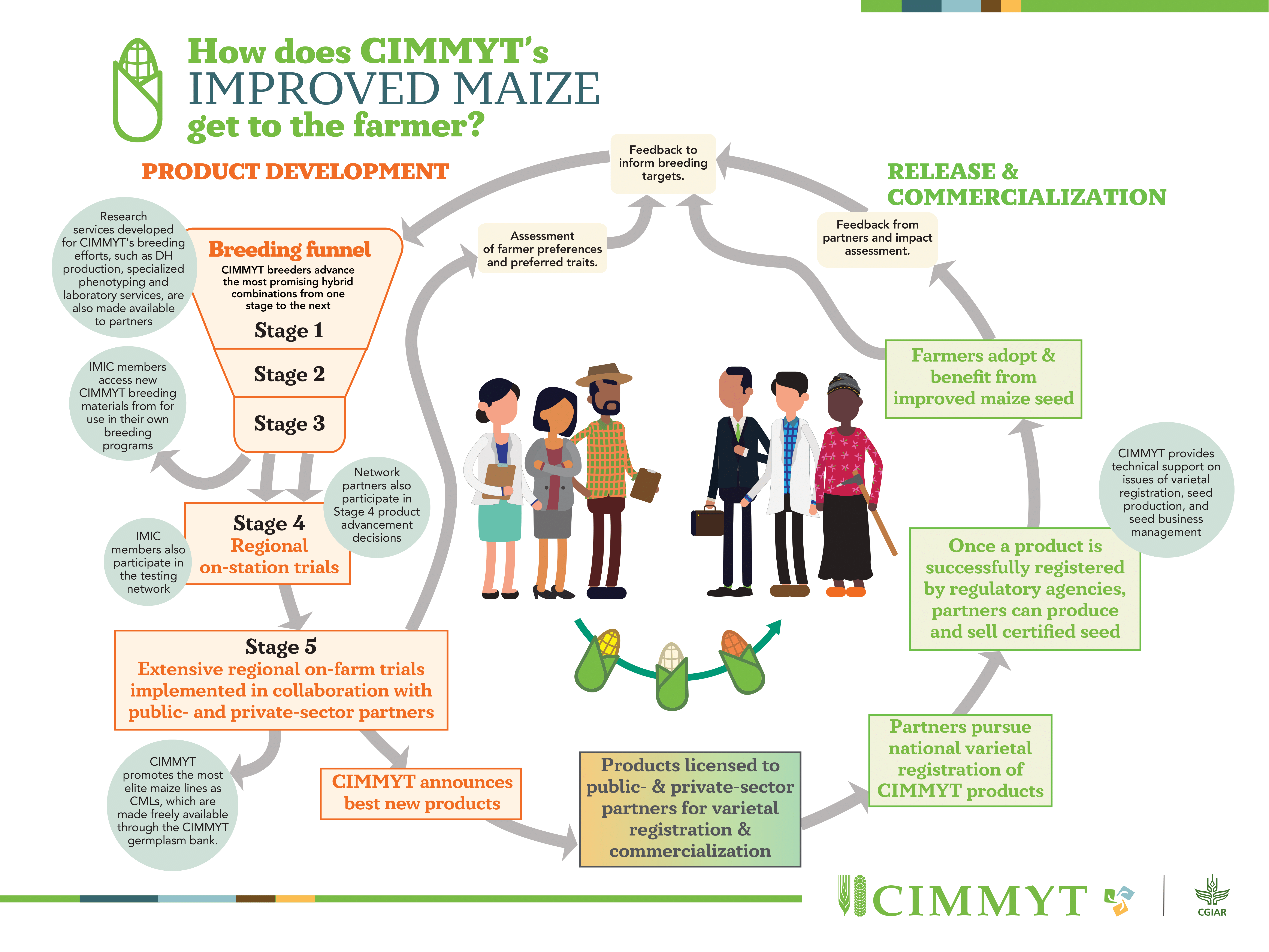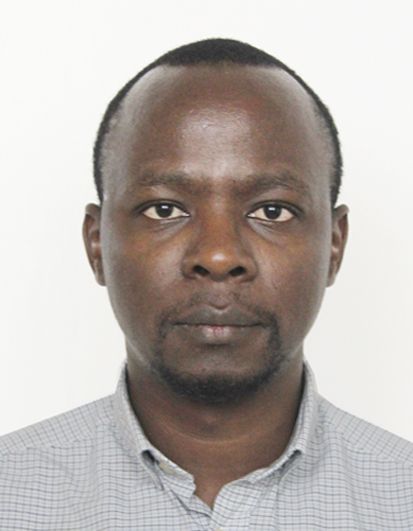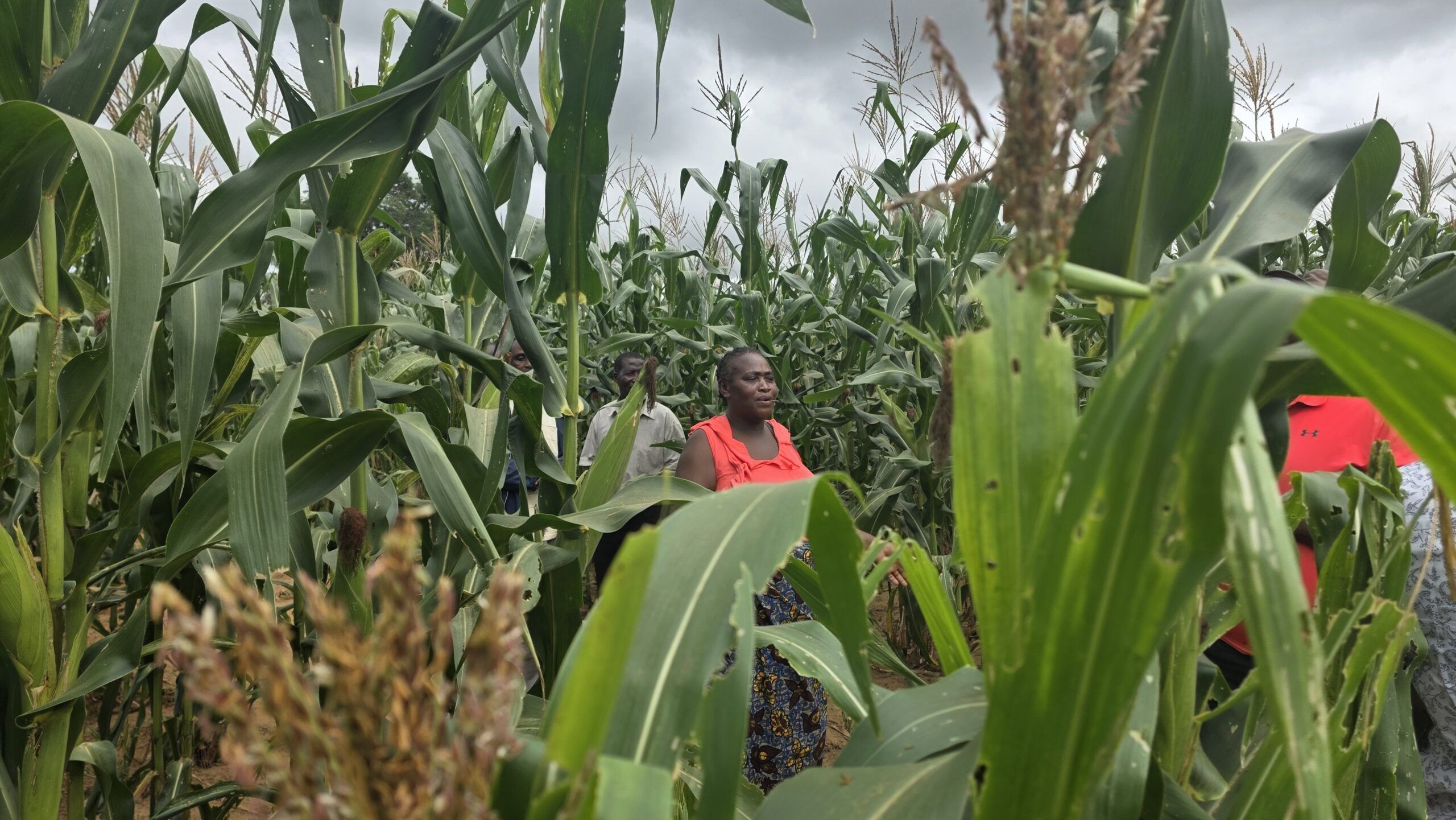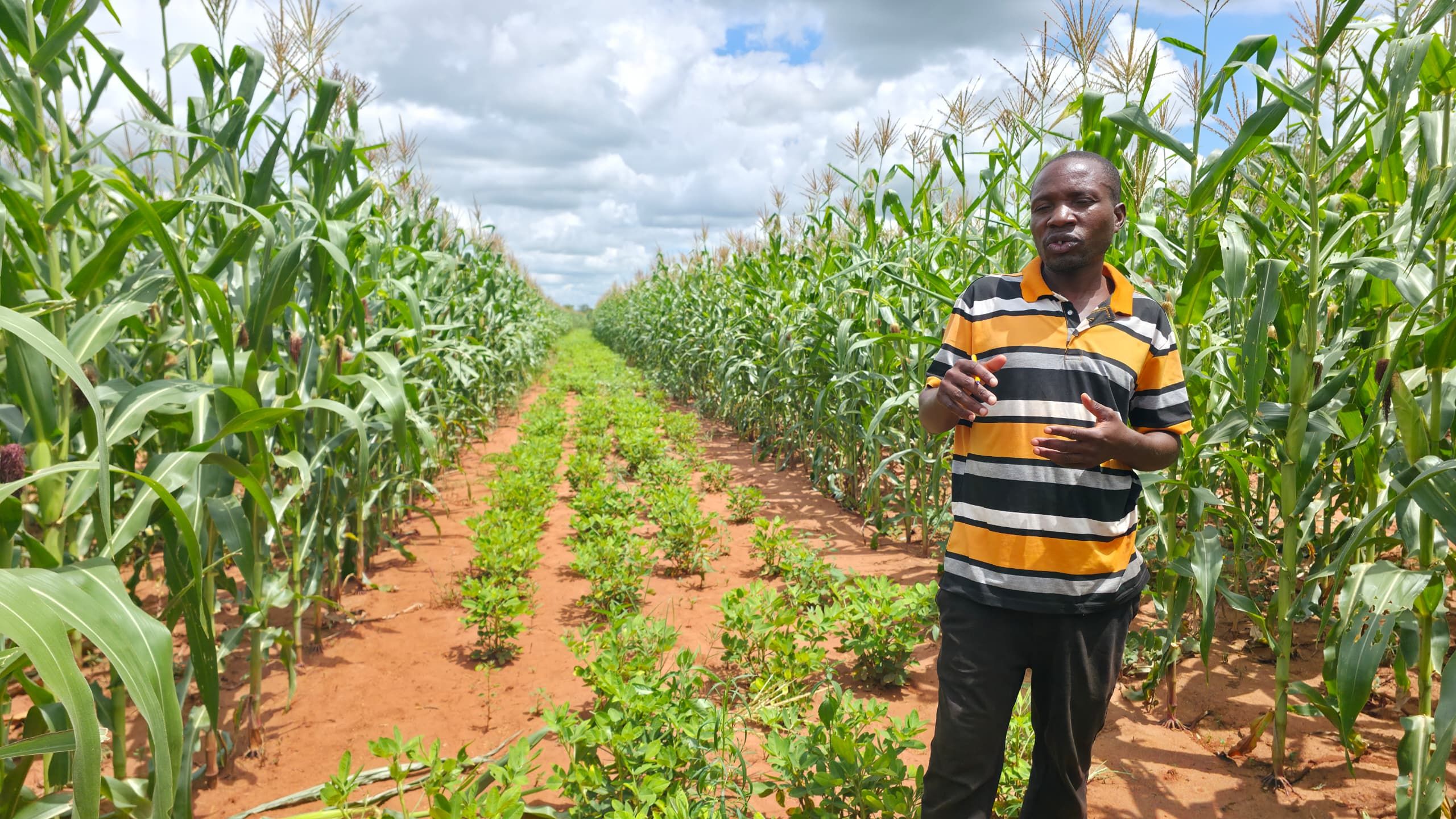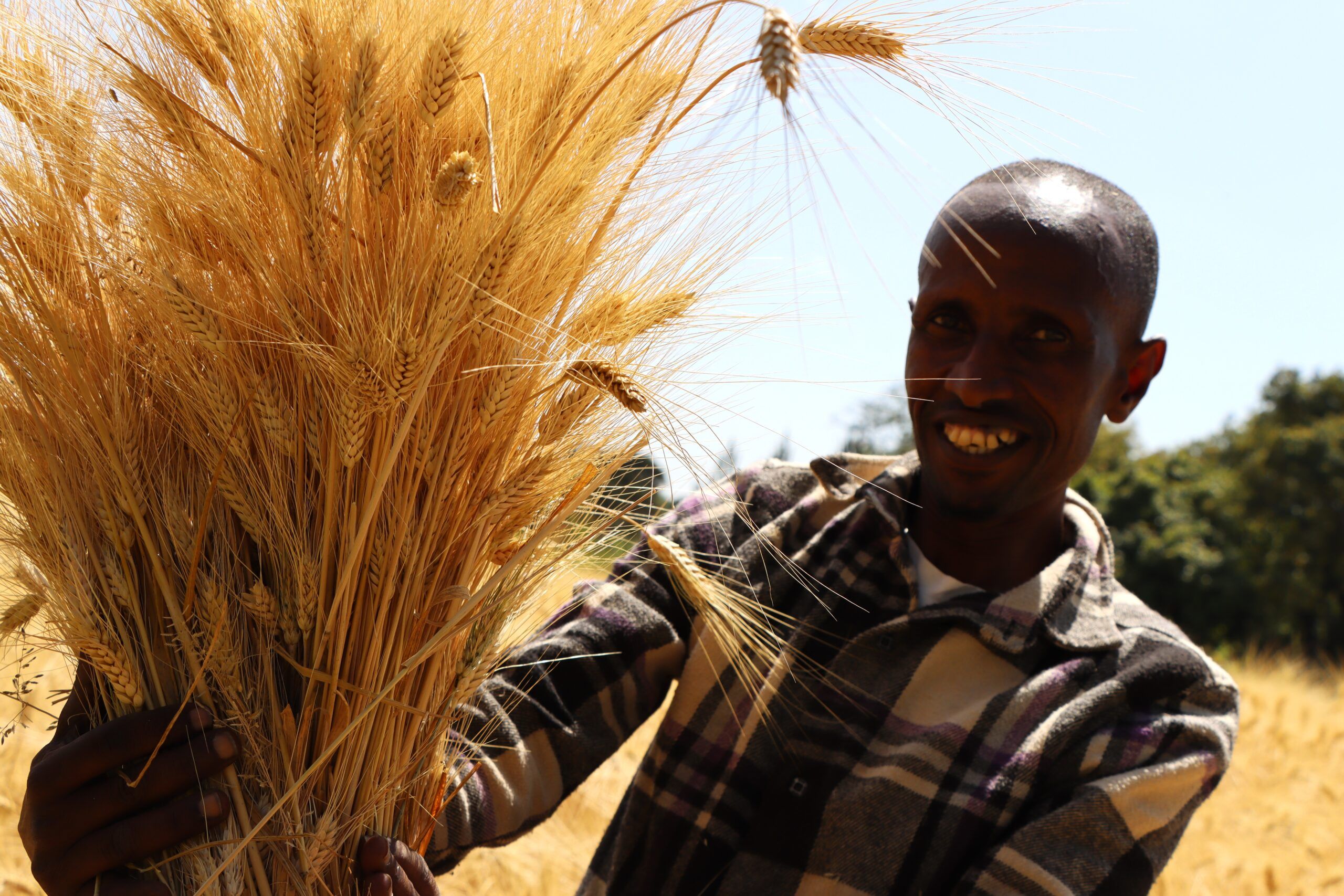Location: Africa
CIMMYT’s work in Africa helps farmers access new maize and wheat systems-based technologies, information and markets, raising incomes and enhancing crop resilience to drought and climate change. CIMMYT sets priorities in consultation with ministries of agriculture, seed companies, farming communities and other stakeholders in the maize and wheat value chains. Our activities in Africa are wide ranging and include: breeding maize for drought tolerance and low-fertility soils, and for resistance to insect pests, foliar diseases and parasitic weeds; sustainably intensifying production in maize- and wheat-based systems; and investigating opportunities to reduce micronutrient and protein malnutrition among women and young children.
Nigeria Releases Hybrid Pearl Millet to Boost Nutrition and Climate Resilience
As a key partner in the release of Nigeria’s first biofortified hybrid pearl millet varieties, CIMMYT contributed its scientific expertise and commitment to advancing climate-resilient, nutrition-rich crops for smallholder farmers. Collaborating closely with ICRISAT, HarvestPlus, and the Lake Chad Research Institute (LCRI), CIMMYT played a pivotal role in supporting the development and scaling of high-yielding, early-maturing millet hybrids enhanced with iron and zinc. This effort reflects CIMMYT’s broader mission to strengthen agrifood systems through innovation and partnership, addressing the dual challenges of malnutrition and climate stress while empowering rural communities across Nigeria’s drylands.
Read the full story.
Reinventing mechanization for Southern Zambia’s drylands: The story of Joe Akombaetwa
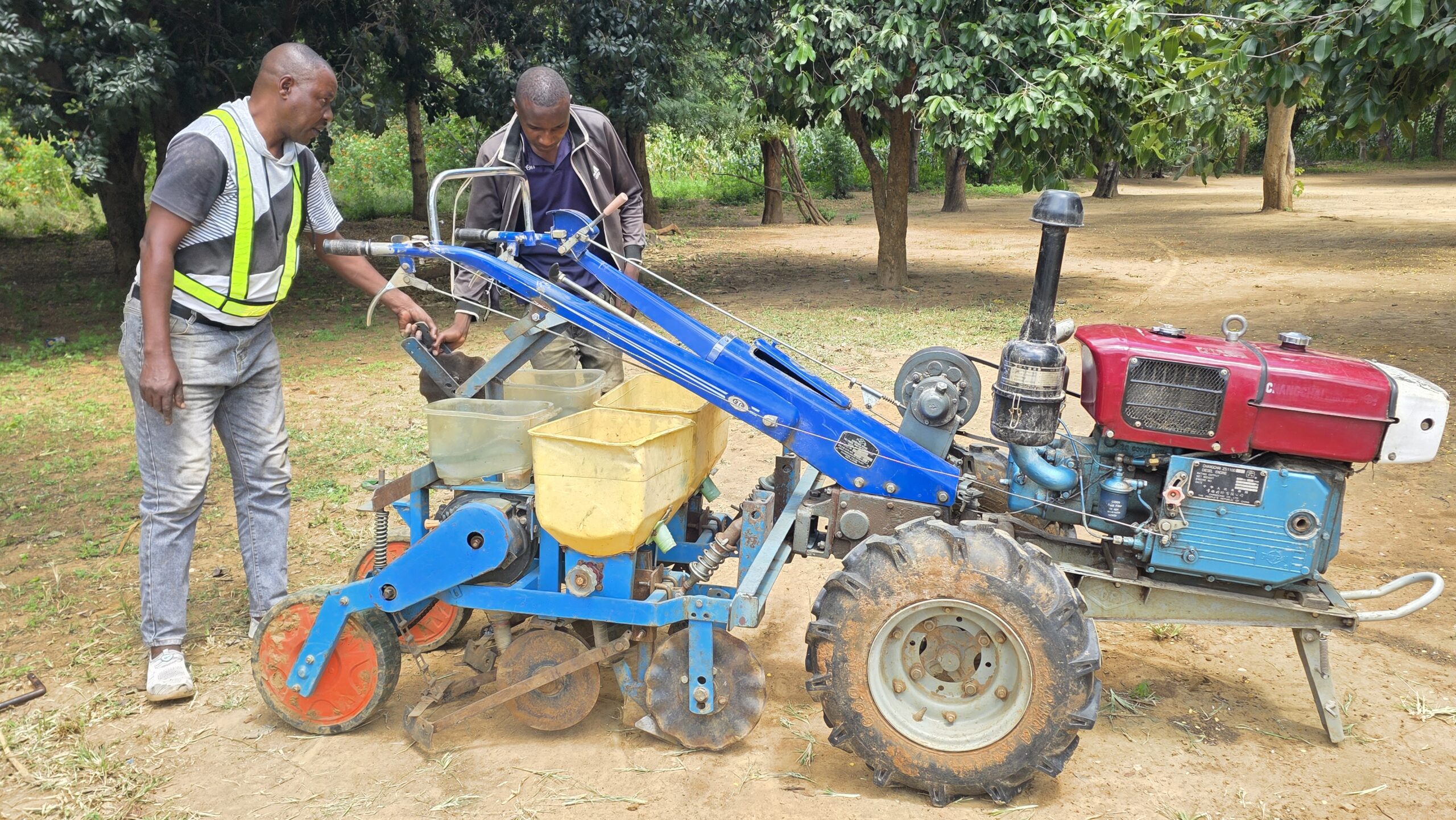
In Dumba Camp, a small farming community in Mazabuka District, Joe Akombaetwa is proving that even in the face of unreliable rains and poor soils, small shifts in how farmers work the land can make all the difference. A farmer since 1992, Joe has lived through the growing impacts of climate change, its frequent shocks to the rain-fed systems, and the high risks it brings to farming families in Zambia’s Southern Province. For the past five years, he has worked as one of the earliest mechanization service providers (SPs) under the European Union-funded Sustainable Intensification of Smallholder Farming Systems in Zambia (SIFAZ) project. As a SIFAZ service provider, Joe acquired a set of machinery, including a two-wheel tractor, a trailer, a multi-crop thresher, and a sheller in 2021. Since then, he has been offering paid mechanization services to farmers in his community. But more than a service provider, Joe is an innovator, a machinery fabricator, and a businessman, creating tailor-made climate-smart mechanization solutions with the support of the SIFAZ project, responding directly to the challenges faced by farmers in his community.
Grounding innovation in reality
Joe’s innovations aren’t conceived in a lab—they’re forged in the field, shaped by the lived realities of his fellow smallholder farmers. One of his earliest breakthroughs came when he collaborated with SIFAZ engineers to design a T-bar to modify the Chinese single-row, no-till multi-crop planters into a double-row planter for a two-wheel tractor, allowing simultaneous planting of two rows instead of just one.
The original single-row planters, while functional, were slow and inefficient. “We wanted to save time and get the work done faster,” Joe explains. “So, we created the T-bar so that two planters could work together in tandem.”
But the innovation didn’t stop there. Joe received feedback from the farmers on the issue of high side separation between the seed and fertilizer openers on the planter. This high side separation of about 120 mm might be useful to reduce seed burning in an irrigated system for which the planter was developed, but Joe and his client farmers in the rain-fed system noticed reduced early plant growth, evidently resulting from delayed nutrient access by young seedlings of the crops. Further, the furrow covered by the press wheels of the planter was not optimum (leaving some seeds uncovered with soil), leading to germination failures.
With his own hands and tools, together with the SIFAZ engineers, Joe redesigned the seed placement system by better aligning the seed and fertilizer openers (with 50 mm side separation) and developing a flexible seed-covering kit fitted before each press wheel on the planter. These modifications addressed what agronomists refer to as “placement efficiency”, but for Joe, it was simply about “getting the seed and fertilizer placed close to each other for the plants to access the fertilizer early and firmly cover the seeds for optimum emergence.” To further improve performance, he added a balancing bar to help stabilize the planter across uneven ground, making the machine more practical for Southern Province’s uneven terrains and varying soil textures.
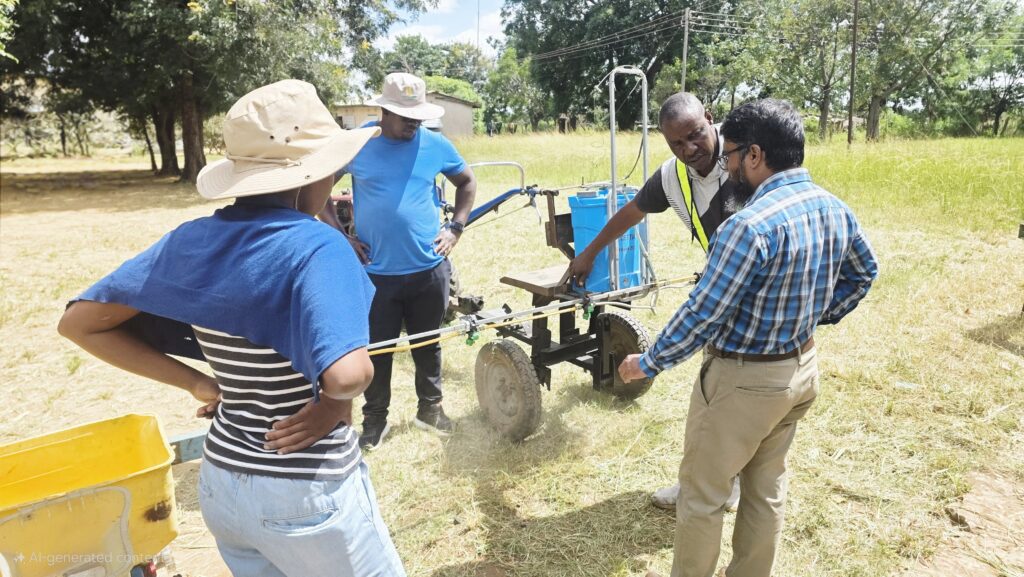
Bridging science with farmer-led solutions
Joe’s hands-on creativity is not new. Back in 2010, he was part of the team that co-developed an animal-drawn ripper, a widely adopted tool that aligns with Conservation Agriculture (CA) principles by reducing soil disturbance.
With a background in blacksmithing and metal fabrication from Kasisi, and early career exposure to seed certification at ACCI in Chilanga, Joe has long moved between formal agriculture and on-the-ground adaptation. Joe is aware of declining draft animals and the aging of the farmers in Zambia, which adds to the challenges faced by smallholder farmers. He sees a declining interest of rural youths in agriculture who do not want to walk behind the beasts or do labor-intensive manual work. Observing the ease with which large-scale commercial farmers operate rippers and boom sprayers, Joe wondered, “Why not adapt this to smallholder needs?”
Joe designed a double-row ripper and a mini boom sprayer for use with a two-wheel tractor. Compared to the traditional animal-drawn single-row rippers or the knapsack sprayers, the two-wheel tractor double-row ripper saves not only time, costs, and drudgery, but also makes farming interesting. “In just ten minutes, I can finish spraying a 16 m by 39 m field,” he says. It’s a leap in efficiency, and for farmers, who often juggle time, labor, and resource constraints, it’s a game-changer! Joe has sold a few rippers and boom sprayers to his neighboring farmers and different projects. The demand for the machinery is on the rise, which encourages him as a rural manufacturer.
Business with a purpose
Joe isn’t only an innovator; he’s also a sharp businessman. From ripping and planting to boom spraying and shelling maize, his mechanization services are in high demand among farmers in and around Dumba Camp. “Ripping has been the most profitable,” he notes. “Almost every farmer now wants it because of the sustainable farming practices introduced by SIFAZ.” He charges based on plot size and crop type, typically around ZMW 200–450 per hectare (approximately US$7–16) for services like no-till planting. But he also knows the realities farmers face. “Sometimes, I negotiate. I don’t want the price to scare away the farmers.” Demonstration days and field shows are his marketing lifeline. From the Cotton Development Trust-organized mechanization field days to local radio promotions, Joe has built a network of trust and visibility. He’s become a go-to name in the Dumba Camp and beyond.
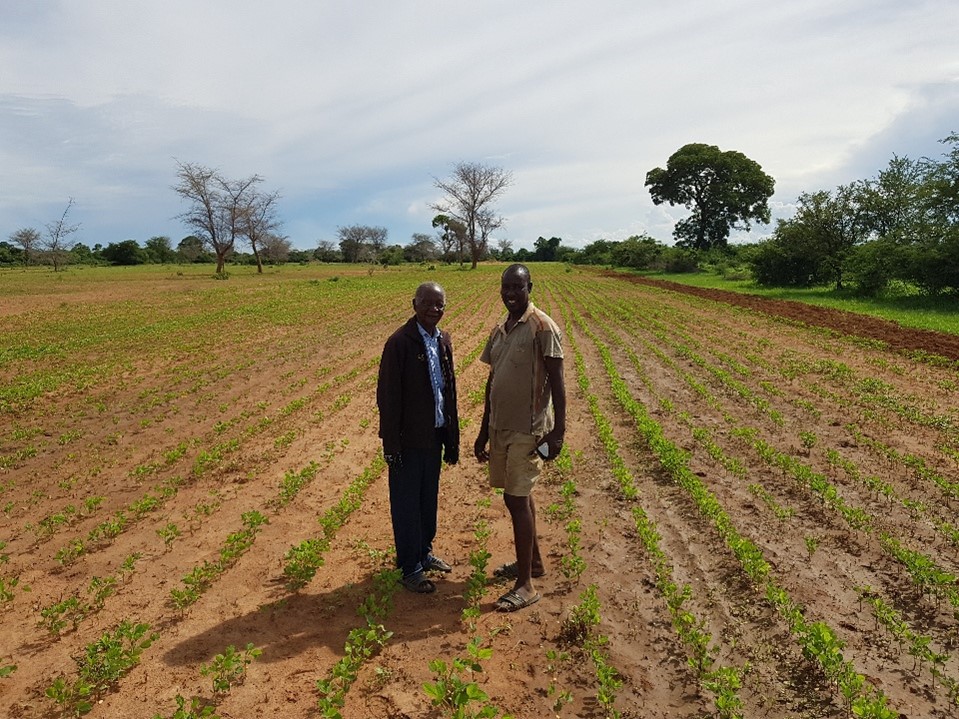
Staying afloat in tough seasons
Last season, the El Niño-induced drought was a huge blow in farmers’ fields. Poor and uneven rainfall and economic strain slashed demand for mechanization services. But Joe stayed afloat by leaning on his farmer instincts. He didn’t sell off all his harvest, but instead, he stored 100 bags of maize and sold another 100 bags to have money for living. That food sovereignty, paired with diversified income from shelling and ripping, kept his business breathing through the drought.
A legacy in the making
Behind the machines and modifications is a father of five, two of whom are already following in his footsteps, bringing civil engineering skills into the family’s growing innovation portfolio. It’s a quiet generational shift powered by resilience, knowledge sharing, and an openness to adapt. Joe’s story reminds us that the future of farming isn’t only shaped by distant policies or global climate models, but also built, welded, and tested in the fields of Southern Zambia, where farmer-innovators like Joe bridge the gap between science and local adaptation.
Seven New CIMMYT maize hybrids available from Eastern Africa Breeding Program
CIMMYT is happy to announce seven new, improved tropical maize hybrids that are now available for uptake by public and private sector partners, especially those interested in marketing or disseminating hybrid maize seed across Eastern Africa and similar agro-ecologies in other regions. NARES and seed companies are hereby invited to apply for licenses to pursue national release, scale-up seed production, and deliver these maize hybrids to farming communities.
| Newly available CIMMYT hybrids | Key traits |
| CIM23EAPP1-01-07 | Intermediate maturing, white, high yielding, drought tolerant, NUE, and resistant to GLS, TLB, MSV, ear rots, and root & stalk lodging tolerance. |
| CIM23EAPP1-02-12 | Early maturing, white, high yielding, drought tolerant, NUE, and resistant to MLN, MSV, GLS, TLB, ear rots, and root & stalk lodging tolerance |
| CIM23EAPP1-02-13 | |
| CIM23EAPP1-02-15 | |
| CIM23EAPP2-15 | Late maturing, white, high yielding, drought tolerant, NUE, and resistant to MSV, GLS, TLB, rust, ear rots, and root & stalk lodging tolerance |
| CIM23EAPP3-40 | Late-maturing, high-yielding, white maize hybrids adapted to high altitudes, with resistance to GLS, TLB, rust, and ear rots. |
| CIM23EAPP3-42 |
| Performance data | Download the Seven New CIMMYT maize hybrids available from Eastern Africa Breeding Program from Dataverse. |
| How to apply | Visit CIMMYT’s maize product allocation page for details |
| Application deadline | The deadline for submitting applications to be considered during the first round of allocations is 14 May 2025. Applications received after that deadline will be considered during subsequent rounds of product allocations. |
The newly available CIMMYT maize hybrids were identified through rigorous, years-long trialing and a stage-gate advancement process which culminated in the Results of the CIMMYT Eastern Africa Maize Regional On-Station (2023 Stage 4) and On-Farm (2024 Stage 5) Trials On-Farm Trials. The products were found to meet the stringent performance and farmer acceptance criteria for CIMMYT’s breeding pipelines that are designed to generate products tailored in particular for smallholder farmers in stress-prone agro-ecologies of Eastern Africa.
Applications must be accompanied by a proposed commercialization plan for each product being requested. Applications may be submitted online via the CIMMYT Maize Licensing Portal and will be reviewed in accordance with CIMMYT’s Principles and Procedures for Acquisition and use of CIMMYT maize hybrids and OPVs for commercialization. Specific questions or issues faced with regard to the application process may be addressed to GMP-CIMMYT@cgiar.org with copy to Michael Nyagowa (m.omondi@cgiar.org), Program Assistant – Seed Systems & Technology Transfer, Global Maize Program, CIMMYT.

Noel Anyuka Templer
As a Seed Systems and Resilience Specialist, Noel applies systems thinking and social science insights to strengthen agricultural resilience in the face of climate change. His expertise lies in empowering smallholder seed systems in tropical regions to adapt and thrive amid evolving environmental and socioeconomic conditions, including in fragile and humanitarian contexts. His ongoing research interests include programming across the Humanitarian-Development-Peace (HDP) nexus and designing integrated approaches that enhance seed security, support sustainable livelihoods, and foster peace. Beyond agriculture, Noel catalyzes locally led climate action, conservation, and public policy by leveraging interdisciplinary approaches to drive sustainable impact. He is committed to translating research into real-world solutions, forging strategic partnerships, and innovating holistic interventions that improve seed security and community resilience.
Sowing knowledge, Reaping impact: Lydia’s journey from trial farmer to community leader in Monze, Zambia
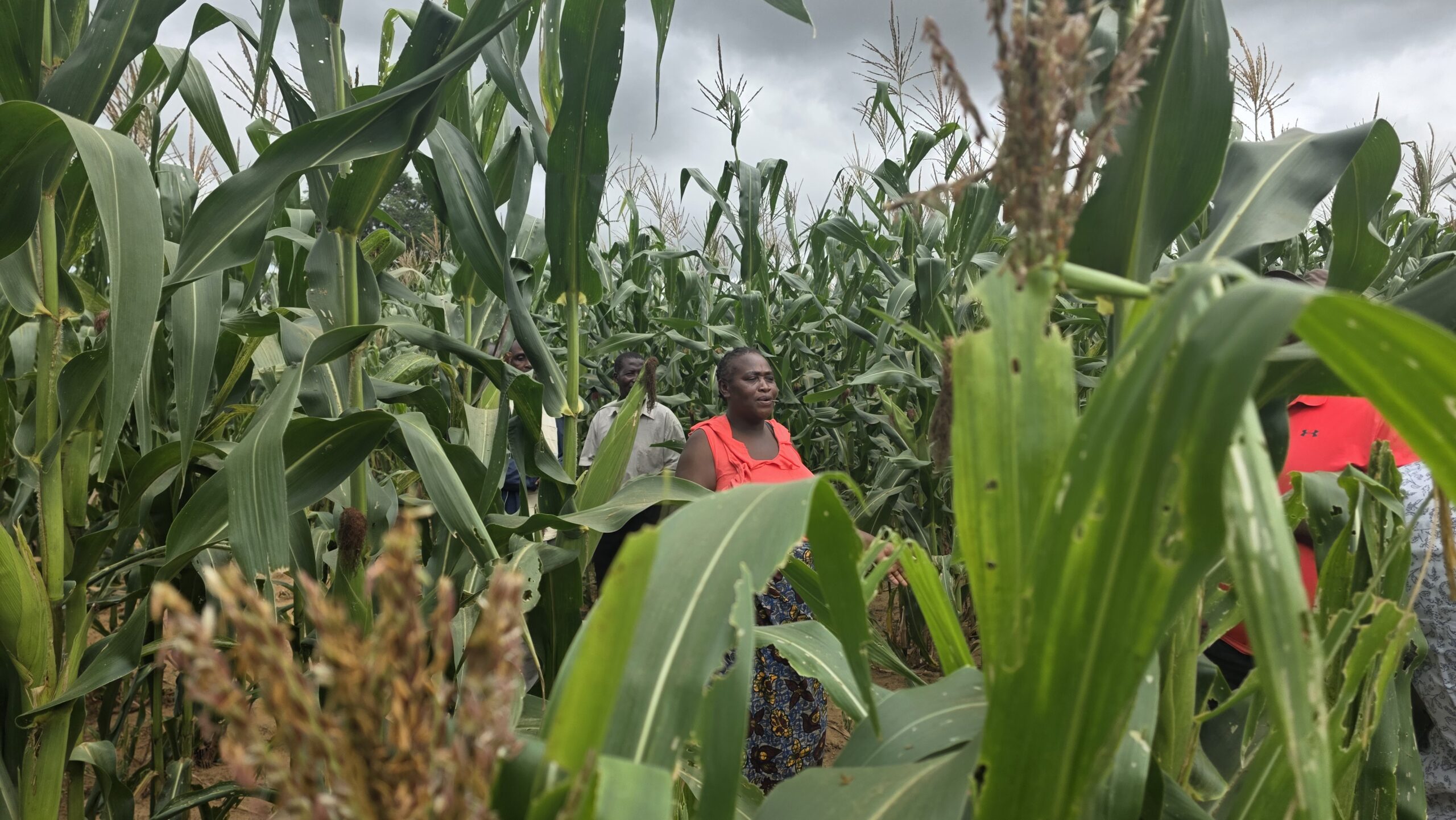
An early morning walk across the fields in Zambia’s Southern province, one is met with maize fields infested with fall armyworm. In contrast to last season’s El Nino induced drought, and as we approached Lydia Siankwede’s field, one is met with her thriving maize and legume field, with its deep-green canopy signaling strong growth and optimal soil health in her crop.
Each morning, Lydia tends to her field with an inquisitive mind, clutching her protocol, which serves as a guide for daily tasks. The dew clings to her shoes as she inspects each plot, checking crop performance, scouting for pests, and noting observations in her trial protocol. Yet beneath this plant vigor, a silent threat lurks—fall armyworm, its larvae discreetly feeding on tender maize leaves.
Her field, which hosts a mother trial under the EU-funded Sustainable Intensification of Smallholder Farming Systems in Zambia (SIFAZ) program, is a patchwork of promising technologies. A mother trial is a farmer-managed, researcher-led experiment that serves as a central site for testing a variety of agricultural treatments under controlled conditions.
Mother trials are part of a mother-and-baby trial approach—a participatory research model designed to test and disseminate new farming technologies while involving farmers in the evaluation process. The approach involves mother trials and baby trials. Baby trials are farmer-managed trials conducted across multiple locations, usually in individual farmers’ fields. Each participant chooses a subset of treatments from the mother trial to test in their own field under specific local conditions. In these mother-and-baby trials, science meets farmer reality, and knowledge grows with every season.
Across the Southern Province, mother-and-baby trials are part of a broader research effort to develop crop intensification practices tailored to smallholder farming systems. In Kazungula Camp, where rainfall is low and erratic, the focus has been on integrating livestock and crop systems, rotating maize with fodder legumes like mucuna and lablab. In other communities, experiments are ongoing with integrating soybean into the maize-based cropping systems and intensifying them with pigeon pea and Gliricidia, both leguminous shrubs that provide fodder and enhance soil fertility. Each treatment is carefully monitored across experimental plots over several seasons to assess its effect on yields, soil health, pest pressure, and its longer-term impact in light of a changing climate.
Lydia, a hardworking farmer with 11 hectares of cultivable land, began her journey as a baby trial implementer, testing a single conservation agriculture (CA) practice in her own field. But her passion for learning and strong work ethic quickly set her apart. Within three years, she transitioned to managing a full-scale mother trial, giving her the opportunity to test a wider array and bundle of technologies across a larger plot. Today, Lydia experiments with crop rotations, intercropping, and fodder management—practices designed to boost productivity for humans, soil, and animals; build resilience; and reduce reliance on chemical inputs.
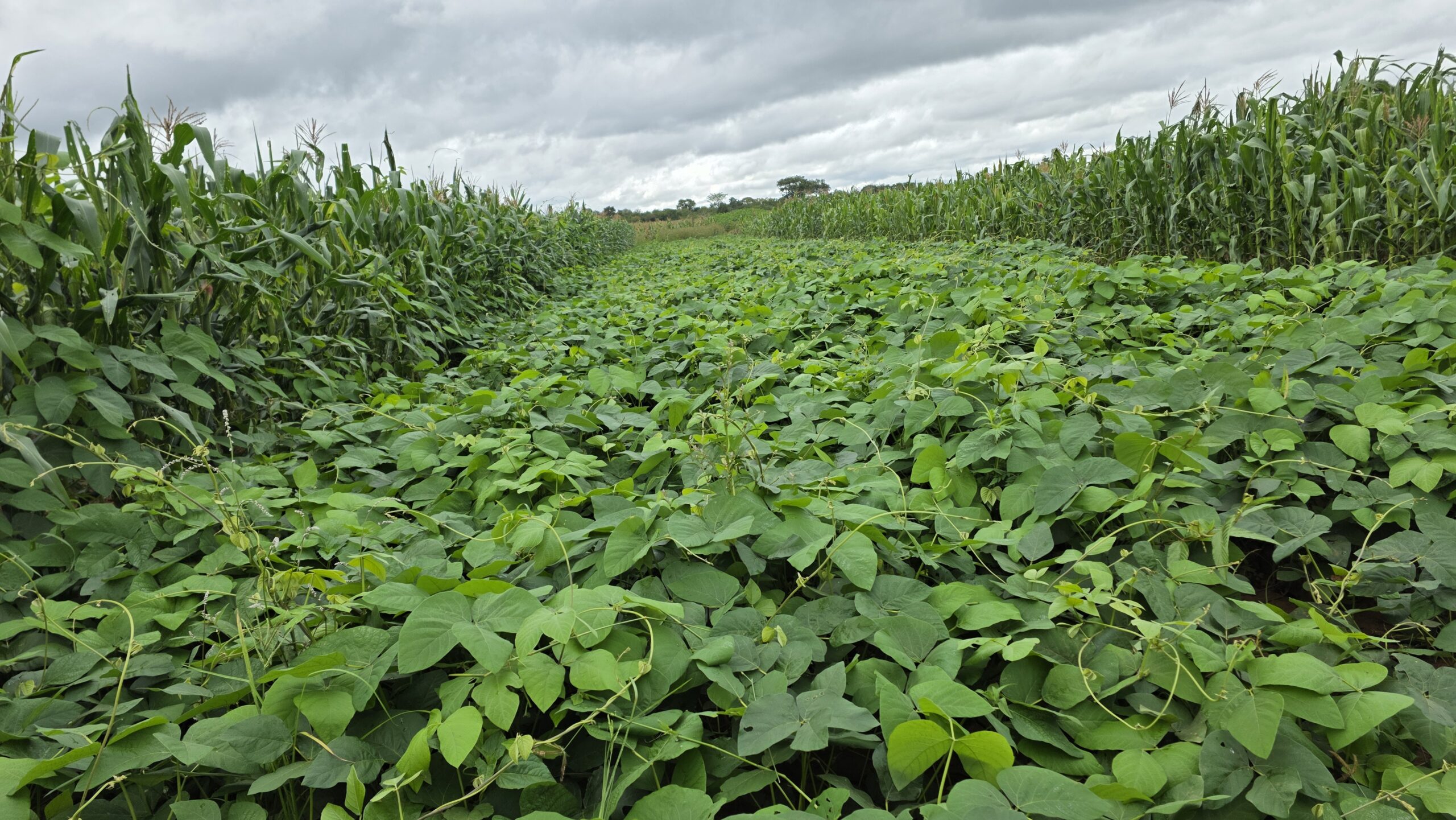
What do the agronomic results bring to the table?
Each season, unique by nature, has brought valuable lessons, with promising long-term results. Since 2021, more than 1,200 farmers in Kazungula Camp, including Lydia, have adopted CA-based crop rotations beyond the trials. While yield gains for maize and legumes are not always immediate, economic analyses consistently show that CA systems generate higher returns compared to conventional tillage systems with sole maize cropping. This proved especially important in years such as 2023/24, when rainfall barely reached 373 mm due to an unprecedented El Niño year. In Kazungula, trials on maize–mucuna strip cropping and maize–lablab rotations showed resilience, with farmers expressing strong interest in growing more fodder and advancing seed multiplication for these crops.
Her reality on-farm
For Lydia, these trials are more than research—they are a valuable tool for transformation. What impressed her most was the maize–lablab rotation. “It’s a game changer for me,” she says. “Lablab suppresses weeds, improves the soil, and even the leaves and pods are useful to eat as relish.” Although lablab is primarily cultivated as animal feed, Lydia’s family has started to enjoy lablab as part of their diet, reducing food costs and increasing nutrition.
In addition, the strip cropping of alternating four rows of narrowly planted maize with four legume rows has also impressed her, especially in terms of weed management. “Weeds are easier to manage, and although armyworm damage is present, it is not destructive,” she explains.
Her determination has grown with each season. Last year, Lydia harvested just 50 bags of maize from scattered parts of her trial field. But instead of pulling back, she leaned in. This season, with better planning and deeper knowledge, she expects to harvest up to 300 bags—enough to feed her household of seven and still have a surplus to sell.
Lydia’s story highlights how participatory research can empower farmers to lead change from the ground up. With access to the right knowledge, support, and tools, she is not merely surviving uncertain seasons—she is farming with purpose.
Milton Malama
Milton Malama is a consultant specializing in community outreach and interventions at the International Maize and wheat Improvement Center (CIMMYT). Based in Zambia, he has eight years of experience working with international agricultural organizations as well as government.
Milton holds a BSc in Agricultural Economics from the university of Zambia and a Collaborative MSc in Agricultural and Applied Economics from Makerere University and the University of Pretoria. His career extends from academic roles in Uganda and applied research across multiple projects in Zambia. As a support staff at Makerere University, he taught courses on Agricultural Commodity Marketing and Small and Medium Business Enterprise Development. His research interests are water management, smallholder agriculture, economic valuation of natural resources, and rural development.
Cynthia Chibebe
Cynthia Chibebe is the Qualitative Research Specialist-Consultant at CIMMYT, working on the Atubandike initiative in Zambia. She has over six years of experience in both qualitative and quantitative research.
Cynthia holds a BSc in Agricultural Economics from the University of Zambia. She has contributed to research projects with organizations such as March Associates, Palm Associates, American Institutes for Research, and ACDI/VOCA. She has co-authored a paper on food and nutrition security which reflects her commitment to generating evidence-based insights that support agricultural and development initiatives in Zambia and beyond.
Cleopatra Kawanga
Cleopatra Kawanga serves as the lead for the implementation of Atubandike digital advisory tool under AID-I project at CIMMYT based in Lusaka. In this role, she works on dynamic content creation for the Viamo 667 platform, an interactive service where farmers can access timely agricultural advice on diverse farming topics. Her primary focus is ensuring that farmers have continued access to relevant agricultural information. She is dedicated to promoting inclusive e-extension approach that bridges the information gap for farmers regardless of gender, age, or location to improve agricultural productivity.
Cleopatra holds a Bachelor of Science degree from the University of Zambia and a Master of Science degree from Sokoine University of Agriculture. Her career path is in food and nutrition security. She has over 6 years of experience in work that supports food and nutrition security among smallholder farmers in Zambia.
Brian Njoroge
Brian Njoroge is a Policy Analysis and Project Sustainability Plan Associate for the International Maize and Wheat Improvement Center (CIMMYT) with 4 years of experience in policy research.
He is currently undertaking an MA. in Research and Public Policy and has attained a BA. in Political Science from the University of Nairobi, Kenya. Having served at the Kenya School of Government; a training and policy advisory institution in Kenya, Brian has undertaken policy analysis and business model development for both public and private sector.
Brian Mpande
Brian Mpande is a consultant specializing in quantitative research at the International Maize and Wheat Improvement Center (CIMMYT), he also plays a coordination role for the Atubandike program. Based in Zambia, he has over six years of experience in agricultural research.
Brian holds a BSc in Agricultural Economics from the University of Zambia and an MSc in Agricultural Economics from the University of Pretoria. His professional background covers both academic roles in South Africa and Zambia, as well as applied research in agriculture and health in Zambia. As a teaching assistant, he contributed to courses on Environmental Valuation and Policy as well as the Fundamentals of Macroeconomics. His research interests include climate-smart agriculture technology adoption, with a particular focus on conservation agriculture. He is also passionate about impact assessment and digital inclusion.
A transformative leap in effective subaward implementation: Inside the revitalized sorghum and millets breeding programs at ZARI
In the heart of Africa’s farming landscape, the Zambia Agricultural Research Institute (ZARI) is setting a new standard for agricultural research and climate resilience, thanks to a critical subgrant from the Bill & Melinda Gates Foundation, facilitated by the Africa Dryland Crops Improvement Network (ADCIN).
Established in August 2023 and convened by CIMMYT’s Dryland Crops Program (DCP), ADCIN is a collaborative network uniting over 200 scientists from more than 17 countries across sub-Saharan Africa. Its mission is to create a dynamic and sustainable community to develop and deliver improved varieties of dryland crops in the region. By leveraging the collective expertise of its multidisciplinary members, ADCIN strives to accelerate the access of enhanced crop varieties to smallholder farmers.
Through this partnership, ZARI has modernized its facilities and practices, creating a model for agricultural innovation in Eastern and Southern Africa. These advancements reflect a powerful vision of enhancing the capacity of breeding programs, improving crop resilience, and boosting food security for communities across the continent.
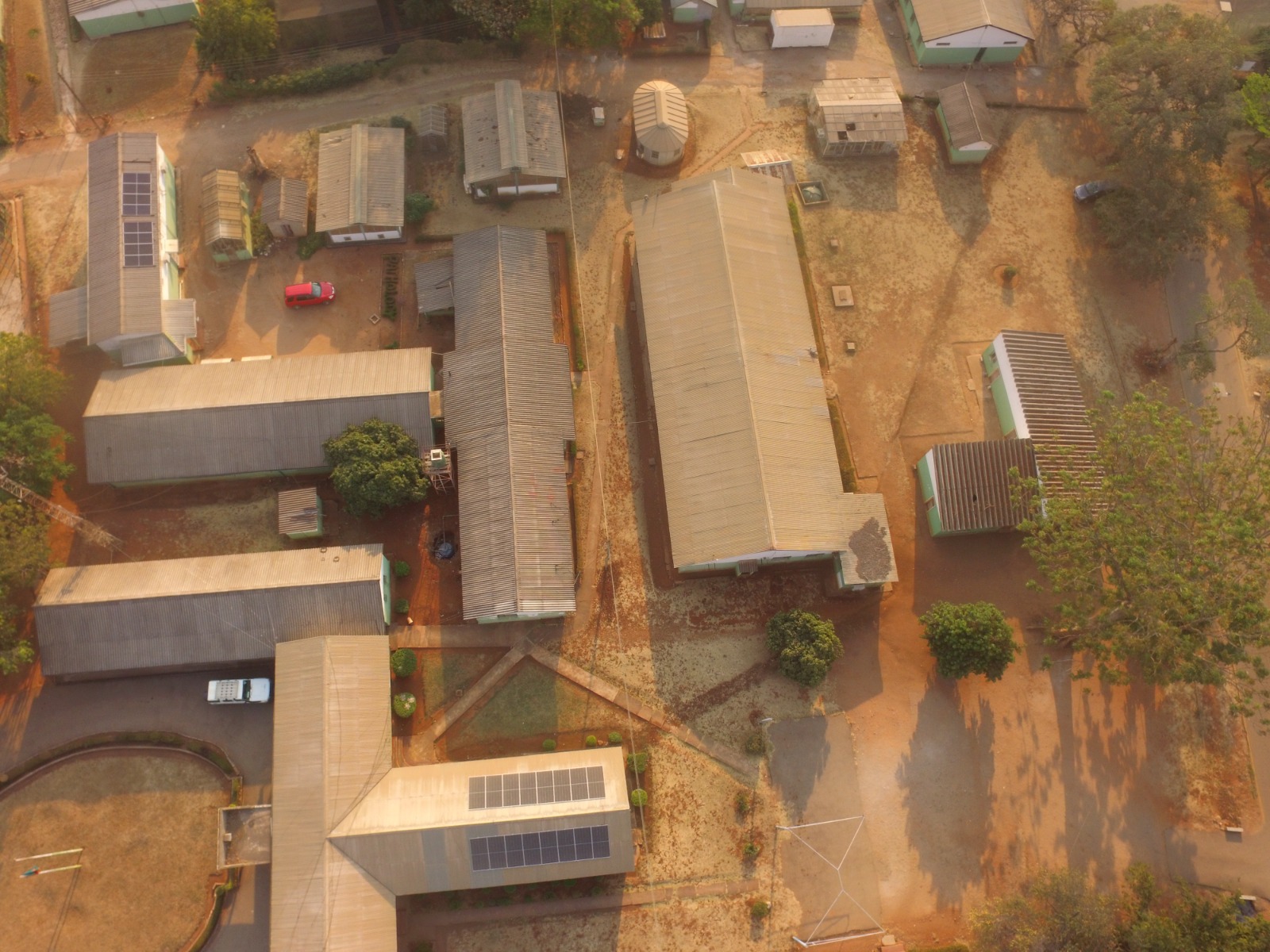
The Challenges of Transformation
Historically, ZARI faced significant challenges that limited its potential. As Lloyd Mbulwe, Acting Chief Agriculture Research Officer at ZARI, recalls:
“We faced research-related hurdles, from outdated lab facilities and inefficient irrigation systems to limited digital infrastructure and insufficient seed storage.”
These issues hindered not only ZARI’s ability to innovate but also its capacity for collaboration with regional and international partners.
With limited resources, ZARI was unable to meet the demand for high-quality, consistent research and innovation. Data collection was often manual, errors were common, and collaboration was difficult. The lack of modern infrastructure restricted the scope of experiments and the institute’s ability to respond to critical regional issues such as climate change and food insecurity.
A New Era of Modernization and Strategic Partnerships
In partnership with ADCIN, ZARI has received targeted funding and technical support, enabling transformative upgrades across its infrastructure that are redefining its research capabilities.
“The upgrades have reshaped our research capabilities,” Mbulwe explains. “With new equipment, enhanced data management systems, and a suitable greenhouse, we’re conducting better plant breeding experiments that directly address the region’s target product profiles.”
In July 2023, CIMMYT’s Dryland Crops Program conducted breeding program assessments of ZARI’s Golden Valley location, where the national institute’s sorghum and millets breeding programs are being conducted. Mark Nas, CIMMYT’s Sorghum and Millets Breeder for Eastern and Southern Africa, describes ZARI’s program as, “a high-potential program composed of talented and dedicated researchers and technicians, but in need of significant infrastructure upgrades if they are to meaningfully contribute to the shared regional breeding pipelines.”
With a subaward granted to ZARI by the end of 2023, Mbulwe and his team quickly worked on implementing the suggested improvements from the program assessments. Key upgrades include a greenhouse facility for speed breeding and controlled drought research, allowing researchers to rapidly produce lines for regional trials, while evaluating regional materials for drought tolerance. Enhanced water storage and solar power installations now enable uninterrupted research, even during power outages, a frequent challenge in this region. Transitioning to Starlink internet has also strengthened ZARI’s capacity for regional and international collaboration, and real-time data delivery, bridging communication gaps and enabling seamless data sharing.
Boosting Capacity for Impact
The new facilities have transformed ZARI’s capacity for impactful research. Rapid generation advance techniques, where breeding populations are quickly advanced through successive selfing generations, allow ZARI researchers to conduct multiple plantings within a year—dramatically boosting progress in line development.
Additionally, the upgrades also enable off-season research through the ZAMGRO Project, which has expanded water storage capacity from 45 cubic meters to an impressive 3,600,000 cubic meters. With year-round breeding, farming and water management research are now possible, giving ZARI an edge in breeding programs.
Mbulwe shares how automated data collection systems and standardized procedures have further improved the precision and reproducibility of ZARI’s research. “Our teams are now equipped to produce high-quality data leading to actionable results,” he says. “These improvements ensure the quality of outcomes and make our processes more efficient.”
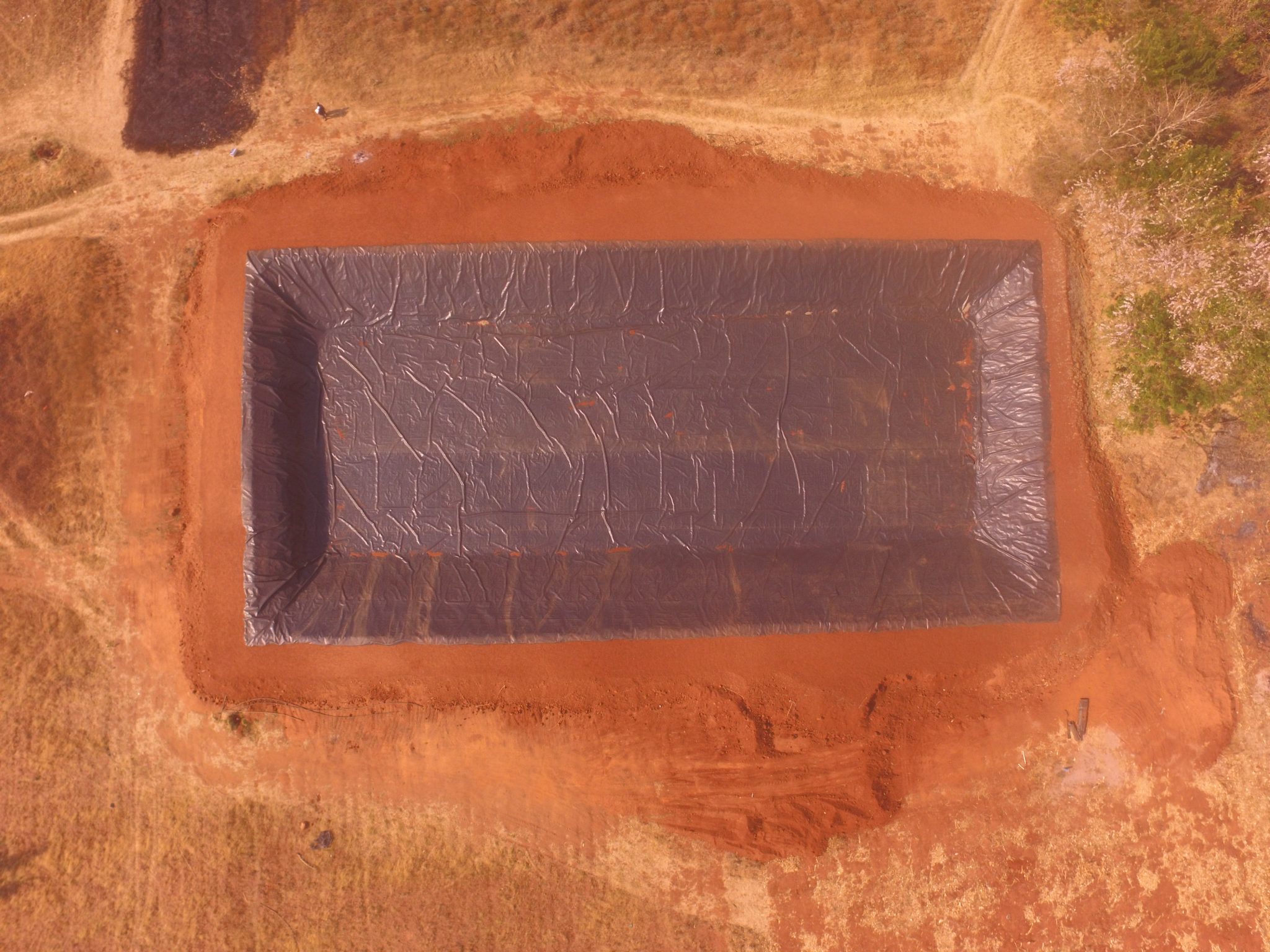
A Vision for the Future
Looking ahead, ZARI plans to scale its research impact by establishing a Center of Excellence for Climate-Smart Agriculture and establishing a biotechnology lab to advance genetic improvement. Expanding greenhouse and irrigation systems, as well as enhancing digital infrastructure for data management, are key priorities. ZARI also aims to strengthen public-private partnerships to bridge the gap between research and practical applications for farmers across Zambia and beyond.
Inspiration and Best Practices for Other NARES Institutions
ZARI’s success story serves as an inspirational blueprint for other National Agricultural Research and Extension Systems (NARES) institutions. Through strategic partnerships, targeted investments in infrastructure, and an emphasis on capacity building, ZARI has shown what is possible when organizations and their leaders commit to modernizing and adapting to the evolving challenges of agriculture.
From irrigation upgrades to energy-efficient, solar-powered facilities, ZARI’s best practices are setting the stage for similar projects in other regions. “We’ve demonstrated that modernization can make a profound difference in NARES breeding programs,” says Dr. Mbulwe. “It’s about leveraging every resource to upgrade our plant breeding capabilities to address the challenges that climate change and food security bring to our region.”
The Role of ADCIN in Agricultural Innovation
ADCIN has been instrumental in supporting this transformation. Through its technical assistance, funding, and strategic guidance, ADCIN has empowered ZARI and other NARES institutions to elevate research standards across Africa. By aligning investments with regional research priorities, ADCIN not only supports individual institutions but also strengthens agricultural networks on a continental scale. Harish Gandhi, Associate Director of CIMMYT’s Dryland Crops Program, states, “We are operating in a new and transformative model of working with our partners. We want our partners to be resourced to succeed.”
ADCIN’s efforts to enhance research capacity, foster collaboration, and improve governance have seen significant returns. “This partnership has made ZARI a stronger institution,” Mbulwe asserts. “Our research output, regional partnerships, and access to funding have all grown. ADCIN’s support reaffirms its commitment to advancing the excellence of regional breeding and other research in dryland crops across Africa.”
Take-Home Message
ZARI’s journey is a prime example of the power of strategic investment, collaboration, and a shared commitment to addressing climate and food security challenges by building the capacity of national programs through equitable subawards. As it continues to innovate, ZARI remains a symbol of progress for agricultural research across Sub-Saharan Africa. With support from ADCIN, ZARI’s advancements signal a brighter, more resilient future for African dryland crops agriculture—one rooted in science, collaboration, and the promise of food security for all.
Scaling conservation agriculture: Victor Munakabanze’s journey from trials to transformative adoption
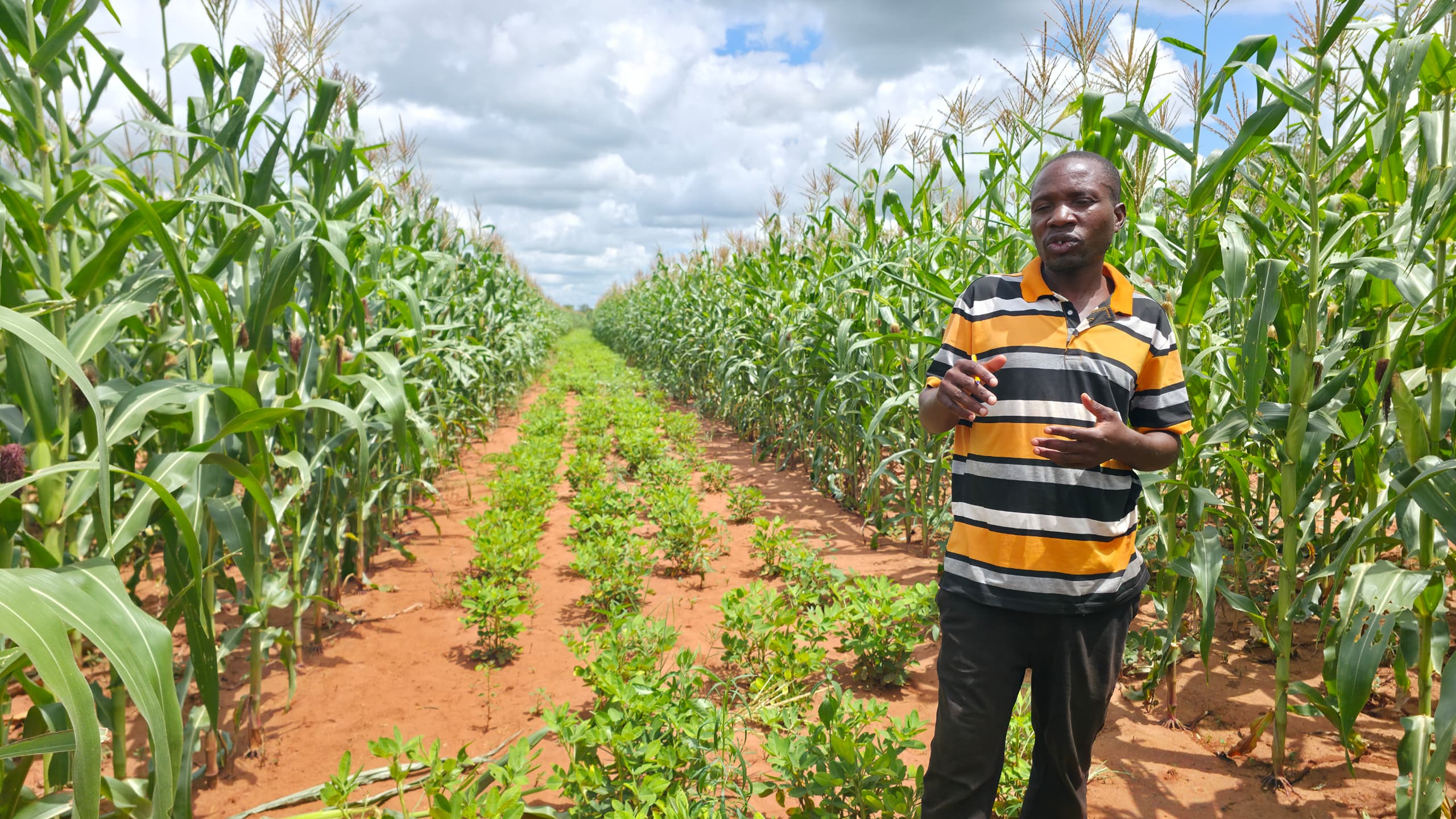
Each annual field tour offers a fresh perspective on the realities farmers face. It’s a window into how different agroecological conditions shape farming experiences and outcomes, revealing what works in farmers’ fields and what doesn’t under an increasingly unpredictable climate.
This year, in Zambia’s Southern Province, the story is promising, as good rains have set the foundation for a favorable crop—a stark contrast to the past season, marked by the El Niño-induced drought.
In the Choma district’s Simaubi camp, Conservation Agriculture (CA) trials paint a picture of resilience and adaptation. The area experiences a semi-arid climate with erratic rainfall averaging 600–800 mm annually, often prone to dry spells and drought years, such as the last, when only 350–400 mm were received. The soils are predominantly of sandy loam texture, with low organic matter and poor water retention capacity, making them susceptible to drought stress.
The area around Simaubi hosts seven mother trials, where a wide range of technologies are tested, and 168 baby trials, where a subset of favored technologies are adapted to farmers’ contexts. Each trial tests different maize-legume intercropping and strip cropping systems against conventional tillage-based practices. As adoption steadily rises, more farmers are experiencing firsthand the benefits of sustainable intensification.
A Champion in the Making
Meet Victor Munakabanze, a farmer with decades of experience and a passion for learning. He began his CA journey as a baby trial implementer, experimenting with the four-row strip cropping system on a 10 m by 20 m plot, with four strips of ripped maize and four strips of ripped groundnuts. Starting in the 2020/21 season—despite a slow start—he persevered. Instead of giving up, he and his wife embarked on a learning journey that led them to scale up and champion CA technologies in their community.
Victor has been part of CA trials under the Sustainable Intensification of Smallholder Farming Systems in Zambia (SIFAZ) project in the Southern Province for five years and has seen the power of small steps in driving change. His initial trial plots sparked hope, showing him that improved yields were possible even under challenging conditions. Encouraged by these results, he expanded his CA practices to a 1.5-hectare plot during the 2024/2025 cropping season, investing in his farm using income from goat sales. He successfully integrated livestock within the cropping system, using goat manure to complement fertilizers—an approach that has not only improved soil fertility but also strengthened the farm’s sustainability.
From Experimentation to Expansion
Victor’s decision to adopt CA at scale was driven by tangible results. He found that intercropping maize and groundnuts in well-spaced rip lines could optimize overall yields better than conventional methods.
However, the transition wasn’t without challenges. In the first season, he started late and harvested little. The following year, delayed planting resulted in just four bags of maize from the 200 m². The El Niño event during the 2023/24 season wiped out his harvest completely. But through each setback, he refined his approach, improving his planting timing and weed management by incorporating herbicides when needed.
Now, his farm serves as a learning hub for fellow farmers from the surrounding community in Simaubi camp. They are drawn in by his success, curious about his planting techniques, and impressed by his ability to integrate crops and livestock. With 23 goats, a growing knowledge base, and a determination to share his experience, Victor embodies the spirit of farmer-led innovation. His story is proof that CA can be practiced beyond the trial plots—it is about ownership, adaptation, and scaling what works.
Inspiring Adoption, One Farmer at a Time
Victor’s journey highlights a crucial lesson: when farmers see the benefits of CA on a small scale, they are more likely to adopt and expand these practices on their own. His resilience, coupled with a keen eye for what works, has made him a role model in his community. From testing to real-world application, his success is growing evidence of the replicability of CA technologies. As adoption spreads, stories like Victor’s pave the way for a future where sustainable farming is not just an experiment—but a way of life.
CIMMYT drives wheat production systems and enhances livelihoods in Ethiopia’s Lowlands through the ADAPT-Wheat Project
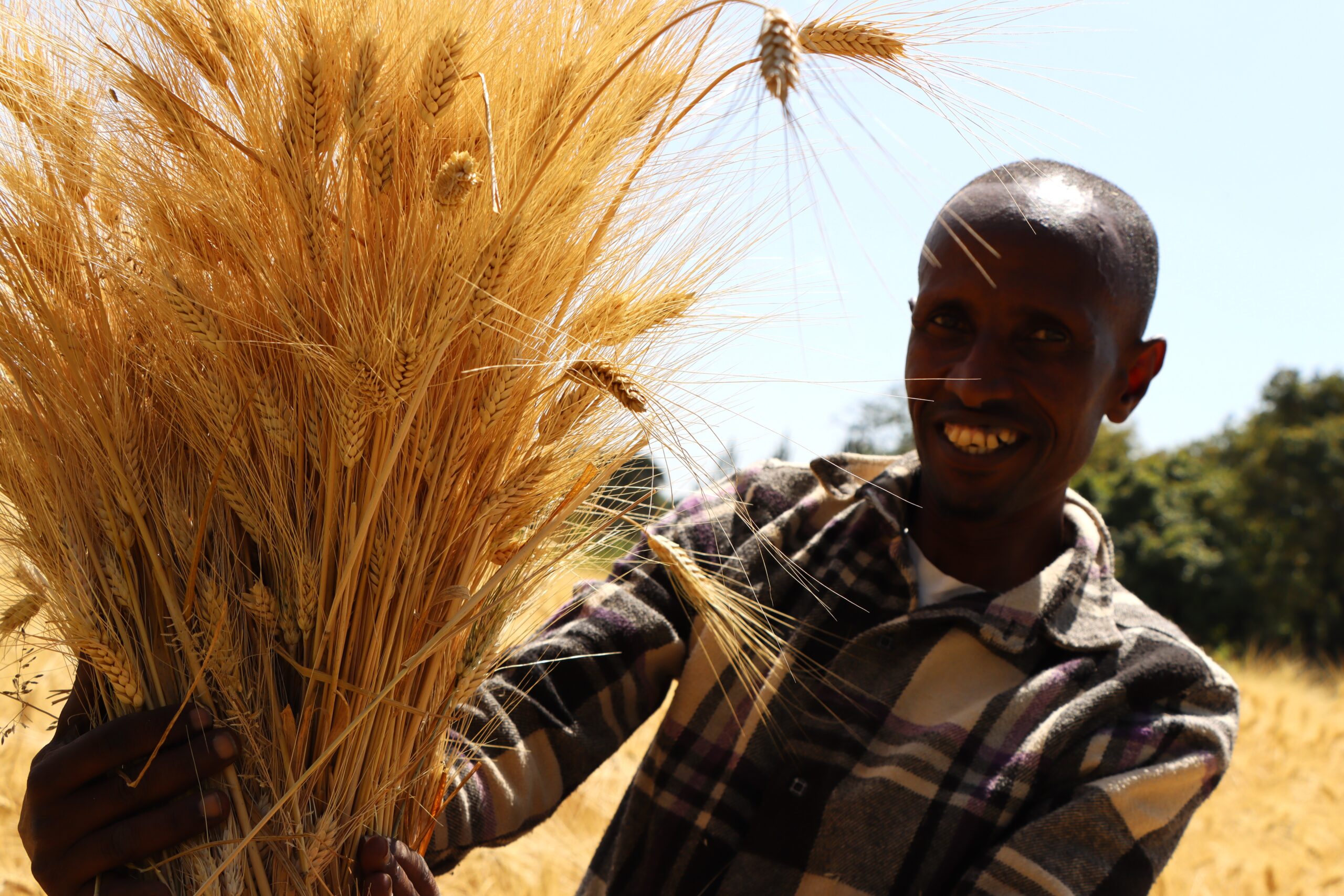
Wheat plays a pivotal role in Ethiopia’s agricultural landscape. As the country’s second most important staple crop, it is crucial to national food security. Traditionally, wheat cultivation has been concentrated in Ethiopia’s highlands, but this has changed with the introduction of the ADAPT-Wheat project—an initiative designed to address the production challenges faced by Ethiopia’s irrigated lowland areas. Led by CIMMYT in partnership with the Ethiopian Institute of Agricultural Research (EIAR), the project aims to tackle key issues such as the lack of stress-tolerant wheat varieties and limited access to reliable seed sources.
Transforming wheat farming in Ethiopia’s lowlands
The Adaptation, Demonstration, and Piloting of Wheat Technologies for Irrigated Lowlands of Ethiopia (ADAPT-Wheat) project focuses on bridging critical wheat production gaps and introducing innovative solutions for smallholder farmers, particularly in the Afar and Oromia regions. By improving wheat production through new varieties and modern technologies, the project is not only increasing agricultural productivity but also transforming farmers’ livelihoods. The initiative aims to directly benefit 1,000 households, with a much wider impact expected across the two regions.
Financially supported by BMZ, the project aligns with Ethiopia’s broader goal of achieving food self-sufficiency. Researchers and national partners have witnessed a significant shift in wheat production practices, demonstrating the success of innovative agricultural technologies and improved collaboration among stakeholders.
Insights from researchers and partners
Bekele Abeyo, CIMMYT-Ethiopia Country Representative and project leader:
“The ADAPT-Wheat project marks a major milestone in Ethiopia’s wheat production journey. It introduces viable wheat technologies that are well-suited for the irrigated lowlands, enhancing both production and productivity in the pursuit of food and nutritional security.”
Tolossa Debele, senior researcher and EIAR–DG representative:
“For years, CIMMYT has been instrumental in advancing Ethiopia’s wheat production system by introducing germplasm, improving varieties, and offering financial, equipment & technical support and training for both researchers and farmers. With the ADAPT-Wheat project, we’ve seen another tangible difference in the livelihoods of smallholder farmers, particularly in the Afar and Oromia regions. The project’s support, including the introduction of modern farm machinery, has not only enhanced mechanization at the farm level but has also contributed significantly to the broader objectives of national agricultural development.”
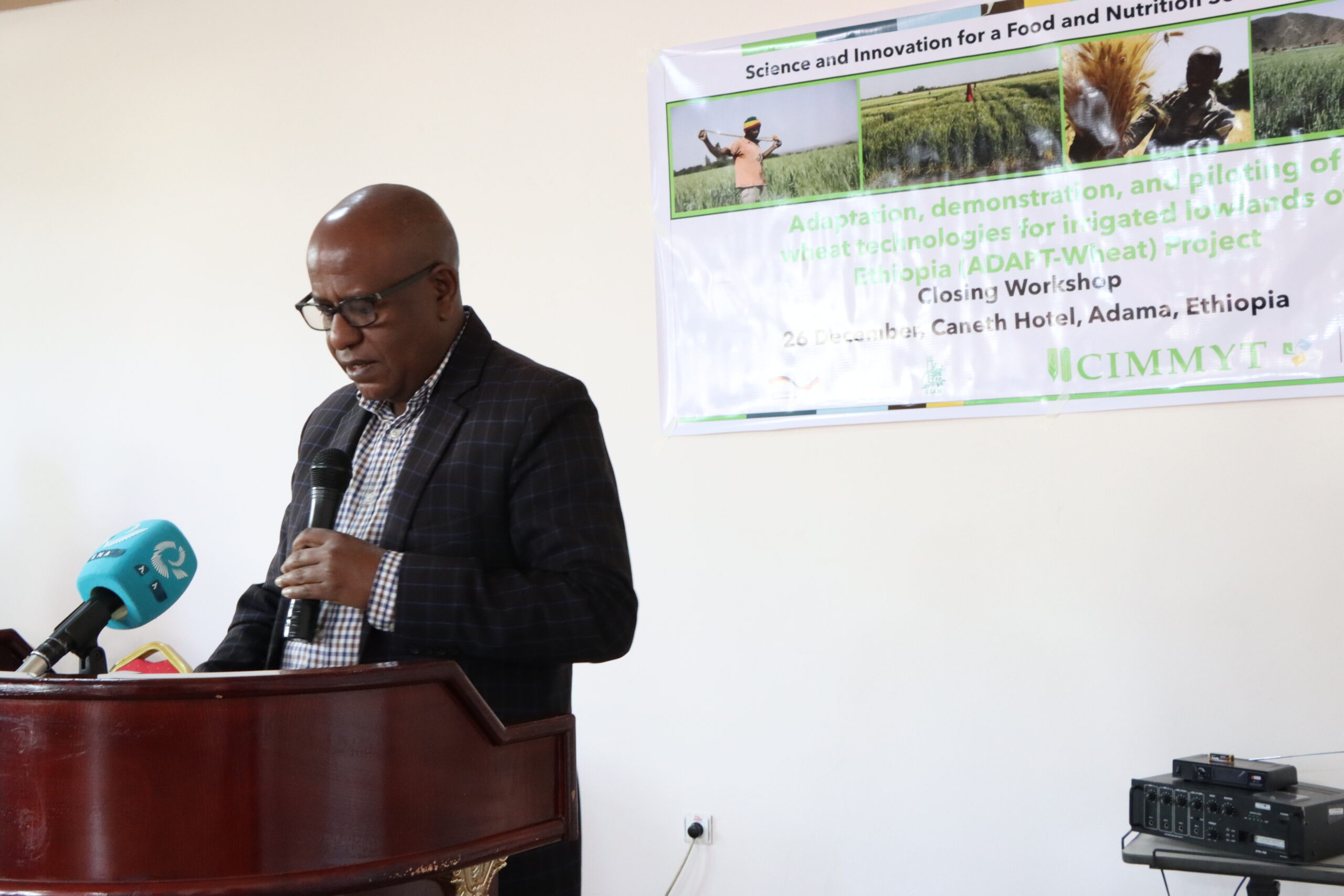
Major milestones and achievements
1. Building capacity for sustainable change
One of the project’s most significant accomplishments has been its strong emphasis on capacity building—both human and physical—to empower local communities in wheat farming. Key capacity-building initiatives include:
- Training for researchers: Software and scientific writing training to enhance technical skills and scientific contributions.
- Training of trainers (TOT) for agricultural experts: Development agents and district-level subject matter specialists were trained to share knowledge with farmers.
The project also included seed distribution, experience-sharing visits, and field days to disseminate knowledge and encourage peer learning. A notable outcome has been informal seed exchange among farmers, amplifying the project’s impact.
Through these efforts, the project successfully reached approximately 4,300 households and engaged a wide range of stakeholders, contributing to human capacity development, seed production and distribution, technology diffusion, and sustainable farming practices.
Additionally, infrastructure development—such as the construction of a quarantine facility and installation of air conditioning units at the Werer Research Center—has strengthened research capacity and maintained high standards for agricultural innovation. The procurement of essential farm machinery has also set the stage for more sustainable wheat farming in Ethiopia’s lowlands.
2. Introducing elite wheat lines
The project introduced 505 elite bread wheat lines and 235 durum wheat lines. From these, 111 bread wheat and 49 durum wheat genotypes were identified for their promising traits, including heat stress tolerance, early maturity, and superior yield components. These lines were rigorously tested across diverse agroecological zones to ensure adaptability.
3. Demonstrating modern irrigation technology and mechanization
The project didn’t stop at improving wheat varieties—it also introduced modern mechanization practices to enhance efficiency and yield. In the Afar and Oromia regions, pilot farms demonstrated advanced machinery such as:
- Subsoilers
- Bailers
- Land levelers
- Planters
- Ridge makers
- Multi-crop threshers
These technologies have been showcased at various farm sites to facilitate adaptation and scaling.
4. Releasing and adapting wheat varieties
The project identified eight wheat varieties (four bread wheat and four durum wheat) suited for Ethiopia’s lowland irrigated conditions.
Additionally, two new wheat varieties—one bread wheat and one durum wheat—were officially registered and released for large-scale production. These releases mark a significant milestone in Ethiopia’s efforts to strengthen wheat production systems.
5. Seed production and distribution
Ensuring the availability of high-quality seeds has been another key priority. Through partnerships with research centers, early-generation seeds were provided to private seed producers and farmers’ cooperative unions. Field monitoring ensured seed quality at harvest, resulting in the production of 430 quintals of certified seed.
Women and youth empowerment strategy
The ADAPT-Wheat project has made a deliberate effort to empower women and youth by ensuring they have access to high-quality seeds, training, and technical support. Notably, women comprised 32% of seed distribution beneficiaries, strengthening their role in improving food security and livelihoods.
Voices from the field: Farmers share their stories
Damma Yami from Jeju district, Alaga Dore village
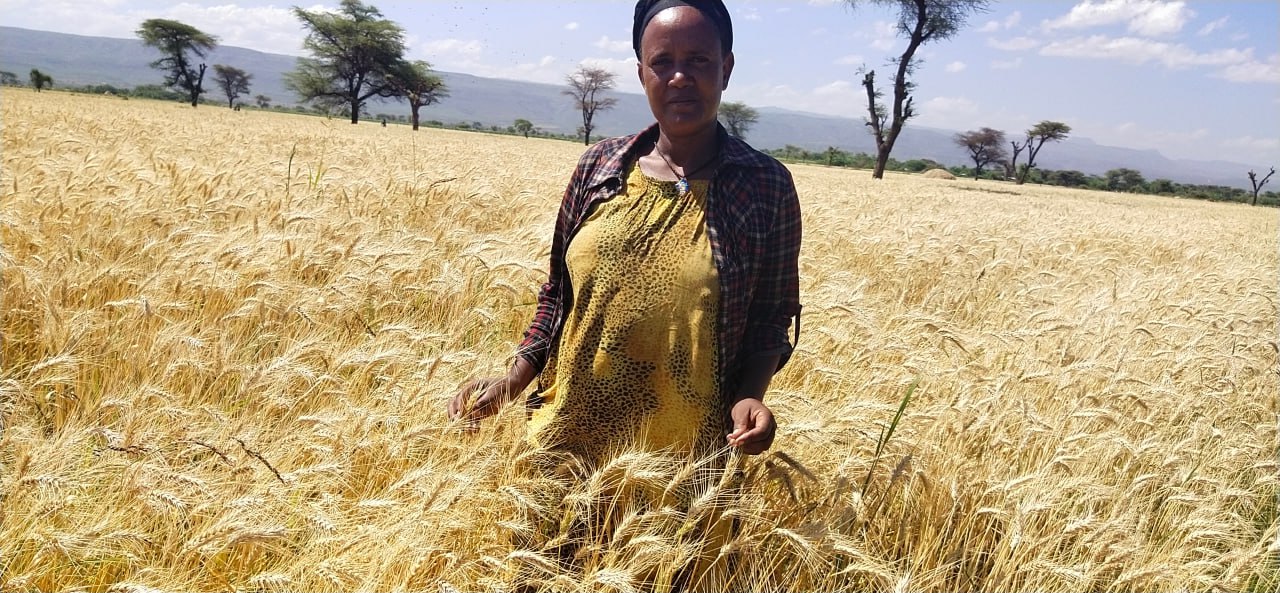
Damma Yami’s story is a powerful example of how innovative agricultural initiatives can transform communities, especially in regions facing harsh environmental conditions.
“For many years, we have lived in arid conditions where livestock farming was our primary livelihood. However, with the challenges posed by weather trends, our traditional systems were no longer sufficient to maintain our livelihoods. The introduction of the ADAPT-Wheat project in recent years has reversed this trend. The project brought us wheat cultivation, as a new and golden opportunity for the farming community. We received high-yielding seeds, training, and technical support on farming practices, and soon we began to see impressive results. The benefits of the project are clear: it provides food for our families, generates income to send children to school, and helps meet other basic needs. As a farmer who engaged in this project, I can confidently say that the project has reshaped our future livelihood.”
Yeshiwas Worku from Oromia region, Arsi Zone, Merti district, Woticha Dole village
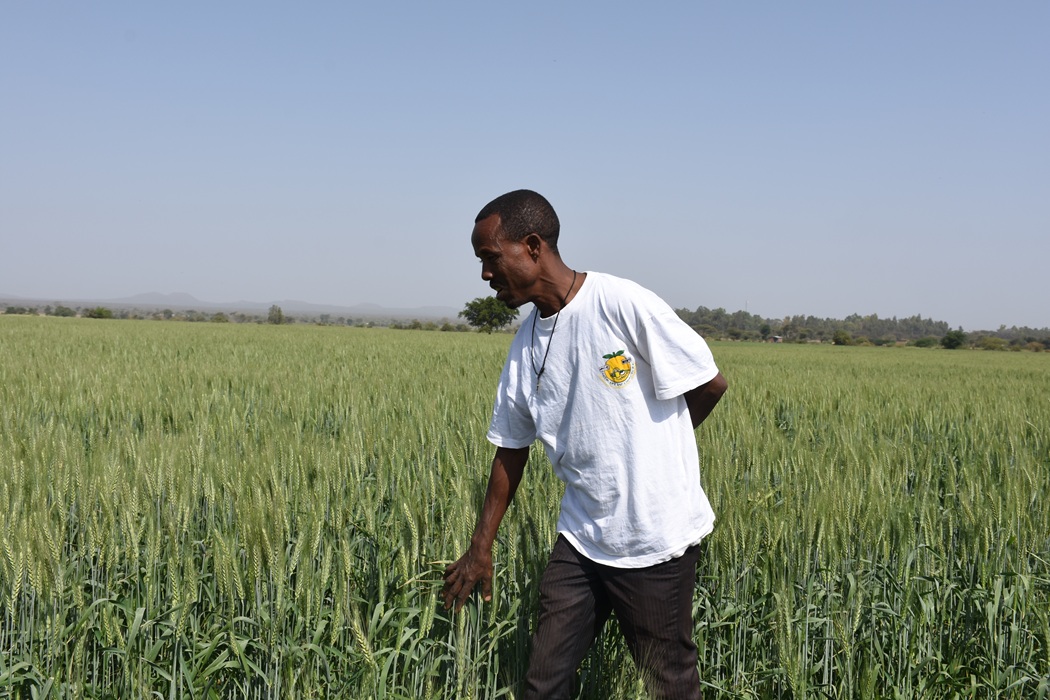
Yeshiwas Worku, a 40-year-old farmer was among those who benefited from the project.
Yeshiwas explains that before the project, wheat cultivation was not traditionally practiced in his area, but it has now become a game-changer for the community. The introduction of modern farming tools, machinery, and access to improved crop varieties has been key to their success. With the help of the project, wheat production has not only become their main source of income but has also helped farmers gain confidence in their ability to sustain their livelihoods.
“We are now familiar with modern farming tools, machines, and practices thanks to the implementing partners of the ADAPT project. We also have access to improved crop varieties, which are crucial for better production and increased income. Now, wheat production has become the main source of our livelihood. This alternative farming opportunity has not only boosted our confidence but has also allowed us to secure a more sustainable livelihood for my family and me. I am deeply grateful to the project implementing partners for playing such a crucial role in transforming our lives. The impact has truly been transformative.”
A transformative impact on wheat production
The ADAPT-Wheat project, alongside CIMMYT’s ongoing work in Ethiopia, has significantly improved wheat production systems and enhanced the livelihoods of smallholder farmers in the lowland regions. More than just a This project is technological intervention, the project serves as a lifeline for smallholder farmers. By introducing innovative wheat technologies, improving seed availability, and empowering local communities, it directly contributes to Ethiopia’s food security goals while fostering economic growth and resilience in rural areas.
As Ethiopia continues its journey toward agricultural self-sufficiency, the success of the ADAPT-Wheat project serves as a model for sustainable agricultural development.
